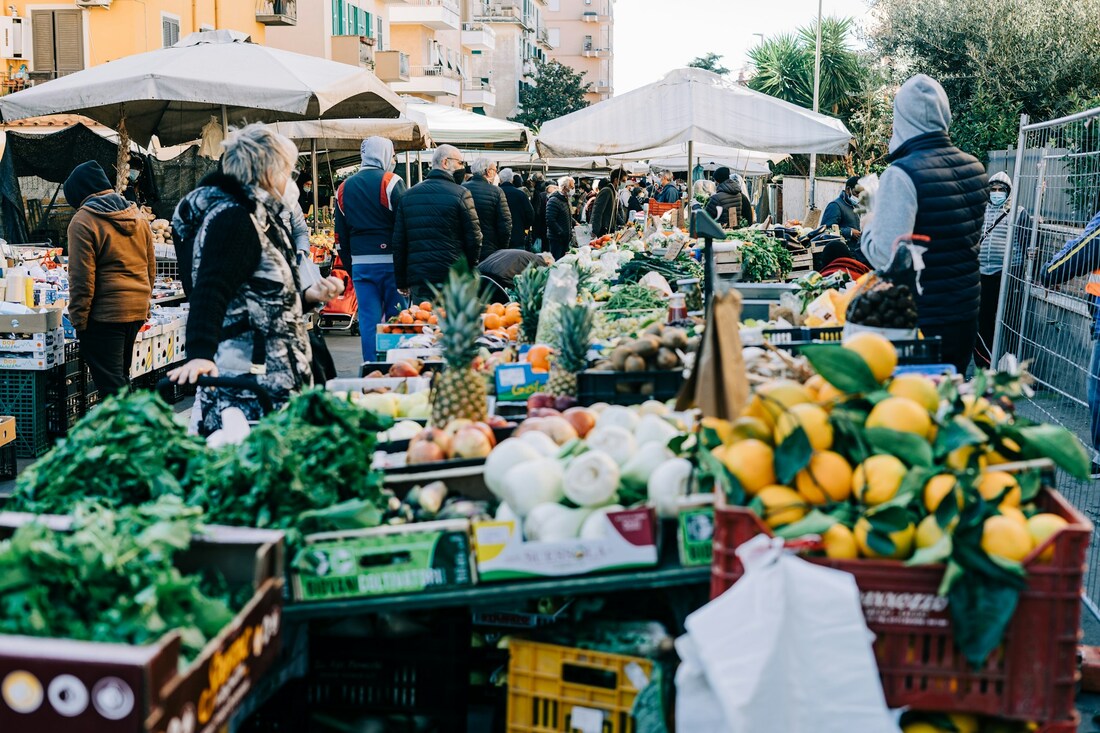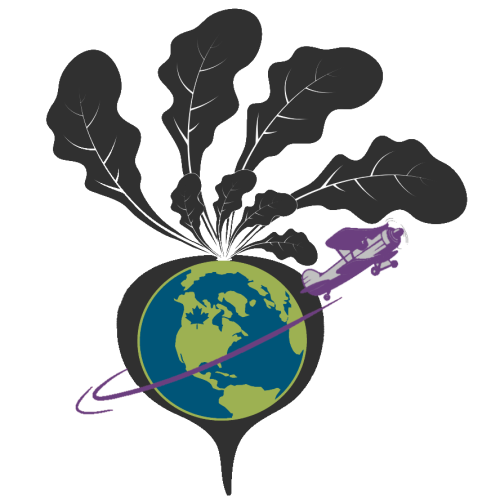Getting around Rome is easy if you have our detailed guide to the city's trains, taxis, and more.  It's worth the effort to get around Rome so you can see great sites like this big market. Photo by Gabriella Clare Marino on Unsplash Rome is a dream travel destination. Its most essential sights - Vatican City, the Colosseum, the Pantheon - are legendary attractions in their own right, some of the most significant historic spots in the world. As such, a trip to Rome isn’t just a nice vacation. It’s a travel essential! And you’re going to want to soak in every moment of it. To fully enjoy the whole city, you’ll need a primer on how to get around Rome - safely and economically. How to get to and from the airport in RomeEvery year, millions of travellers pass through Rome’s Fiumicino - Leonardo Da Vinci International Airport. It is one of Europe’s busiest airports in terms of passenger traffic and is the home base of Alitalia’s operations. My memories of Fiumicino are positive, and I especially noted the good cappuccino (truly what matters in this world!) and high-end window shopping. But I wasn’t keen to linger there at all. I couldn’t wait to enter Rome, and I suspect you’ll feel the same way! Here’s a breakdown of your options for making your way into central Rome, with costs and pros and cons to help you decide. Fiumicino Airport Hotel Shuttle ServiceA hotel shuttle bus (really a minivan) from Fiumicino Airport to your central Rome hotel will cost about 20 Euros. This is a fantastic option for solo passengers arriving later in the evening. You’re brought directly to your hotel’s front door, and there’s no need to struggle to buy metro tickets or walk after dark. And it’s less expensive than a taxi! On the downside, you have to book your shuttle in advance. You’ll have to wait until all the other reserved guests arrive before your driver departs, and depending on the route, you might be the last person to be dropped off. Your destination must be a registered hotel. Airbnb guests can only be dropped off at the closest nearby hotel; from there, they’ll have to walk. And the hotel shuttle is not always economical. For three people or more, a taxi is cheaper and quicker. This is best for anyone who needs extra assistance getting to their hotel for the first time and isn’t in a rush. Terravision BusThe Terravision bus is the most economical airport transportation option. It costs just 6 Euros for a one-way trip between the airport and central Rome or 11 Euros for a round trip. You’ll save a little bit by booking online in advance, and you can change your departure times. The Terravision bus runs approximately every 45 minutes, and the trip to Fiumicino Airport takes just under one hour. Is Terravision a smidge cheaper than its competitors and the only bus company with a ticket office within Rome’s central station, Termini. It even has a waiting area at its Terracafe! It’s located on the station’s east side, while the competing bus companies hang out on the side streets next to the terminal. It’s cheap, convenient, and relatively easy. The only downside is that it’s not ideal for travellers in a rush. Leonardo Express versus FI Commuter TrainThe Leonardo Express train is a dedicated airport express train that takes 30 minutes to travel between Rome’s central station, Termini, and Fiumicino Airport. It departs every fifteen minutes from platform 23 (occasionally platform 24) at Termini. Tickets cost about 14 Euros, which is more expensive than other public transportation options but cheaper than taxis or the hotel shuttle buses. It’s quick and comfortable, and the consistent departure from the same section of Termini means it’s easy to catch the train if you’re running late in the morning! You can also purchase your ticket in advance. Note that you have to select a departure time, and while you can always use your ticket to take a later train, you can’t use it to travel earlier. Despite the high cost compared to the Terravision bus, it remains my preferred method for connecting to the airport, especially in the morning. A delayed hotel checkout one morning left me sprinting for Termini, and I am incredibly grateful that I had purchased my Leonardo Express ticket the evening before. I knew exactly which platform to dash to, and I knew that even if I missed my departure, another would be along in a few minutes and get me to the airport in record time. Taking the public commuter train, the F1 is a slower but cheaper option. For 8 Euros, you can connect with the FI line from most metro stations (but not directly at Termini, though you can switch metro lines and connect later on). It takes about an hour to reach the airport. The FI is best if you stay close to a central train station other than Termini, such as Trastevere, Ostiense, and Tiburtina. It’s easy, economical, and much more direct than making an unnecessary pit stop at the central station. But if Termini is indeed your stomping grounds, you’re better off splurging on the Leonardo Express train or saving the maximum amount of money and taking the Terravision bus. Taxis and Ubers in RomeA taxi from Fiumicino Airport to Rome’s city center is a flat rate of 48 Euros for four passengers. The drive takes about 45 minutes, and traffic is dependent. This is the most expensive transportation option for solo travellers or couples - and it’s not even the quickest! Even the splurge-y Leonardo Express costs less and takes less time. However, this is the best choice for families or people with excessive luggage. One of the most important things to check is the origin of the taxi company before getting on board. The Rome authorities set the fare at €48. However, if the taxi has its fare fixed by the Municipality of Fiumicino, it is €60. (I assume it’s because the Roman taxi drivers are heading back to the city, which is their home base, so they can easily pick up a fare in the city centre, while the Fiumicino drivers basically need to head back to their region, so they’re kinda forced to make a round trip when they bring you into Rome...) So make sure you know where your taxi company is from and look for a City of Rome taxi if you are going to the historical centre of Rome. However, other local alternatives, including private car hires, provide prices on par with taxis. This is a good option for parties of three or four people, as it often includes little perks not found in taxis (like bottled water). You can also arrange an indirect route to your hotel, turning your car ride into a mini tour past the Colosseum and Pantheon. Uber exists in Rome, but it’s not the inexpensive, carefree option it is elsewhere. Only Uber Black can operate, and surge pricing is often in effect. It’s not an excellent choice for airport transportation. Should you rent a car in Rome?There’s a great scene in Melissa McCarthy’s movie Spy in which her title character, Susan, is picked up by her local fixer in Rome, Aldo. Aldo embodies every exaggerated stereotype of Italian men, from outrageous flirting to daredevil driving. Susan is taken on a heart-stopping drive through Rome, arriving at her destination at record speed, albeit somewhat terrified. Aldo’s “skills” certainly come to mind when people envision what Rome is like for driving. But rest assured, it isn’t THAT bad. As with any large city, you’ll have traffic jams, the odd crazy driver, and some tight squeezes here and there. If you need to drive in and around Rome and feel slightly terrified, thanks to Aldo and his movie brethren, rest assured that it’s not *that* bad. It is, however, very different from what you’re likely familiar with as a North American motorist. For instance, you’ll have to acquire an International Drivers Permit (easily purchased at any AAA or CAA office) to rent a car in Italy. New drivers in Rome also need to be aware of the ZTL, or limited traffic zones, where only taxis and locals with special permits can go. If you’re unsure what’s permitted, look for the words Varco Attivo (active gate) or Varco Non-Attivo (non-active gate). You can only enter when the virtual gate - aka the barrier to non-essential traffic - is “non-active” or lifted. Otherwise, you can expect to be fined thanks to the extensive camera system, which will nab your licence plate even if you have only transgressed a few blocks. Another essential feature is the white pedestrian right-of-way stripes painted on the roads. As a pedestrian, I personally never trusted them. Always look both ways, friends! But as a driver, you are responsible for letting them pass safely. White, however, is your friend when it comes to parking. A white-painted spot means that it’s free! However, as expats will tell you, finding a white parking spot is akin to spotting the Loch Ness monster. If you see one, TAKE IT. Don’t you dare circle the block, hoping for something just a bit closer! Blue parking spots require payment with a metre system similar to what you’d find at home. Finally, parking garages are a popular option, like anywhere else worldwide. Renting the most minor car is an excellent strategy to save on rental fees and fuel and squeeze into the tiniest available spots! In short, if you’re hoping to make several day trips to areas not quickly served by public transit, consider the freedom and flexibility of renting a car. If you stick to the city centre and major attractions, public transit and the occasional taxi will serve you well. Walking in RomeRome is a beautifully walkable city. Sure, there are some bumpy cobblestones here or there, but nothing to stand in the way of a long, leisurely walk throughout the city. I often would start out early in the morning, take the main drag to the first attraction on my list, and then weave my way back, popping into little cafes and small churches along the way. When my feet gave out, I would hop on a bus headed back toward a significant tourist attraction, knowing I could easily stroll home. Of course, Rome is heavily visited. This inevitably means pickpockets, especially in the streets around popular attractions and on the busiest buses. They operate on stealth and opportunity. Don’t be their easiest target. Minimise the valuables you have with you and ditch the open, over-the-shoulder tote bags in favour of cross-body bags that zip close. What to know about Rome's public transit systemWith just two main lines—blue and red—Rome has one of Europe’s most straightforward metro systems. It’s also the smallest, relative to the overall size of the city. This isn’t because Romans don’t love their “Metropolitana”—it’s because drilling and digging in the Eternal City is fraught with difficulties. There is an ancient temple here and a priceless cistern there. Expanding the system isn’t exactly going to happen overnight!
Thankfully, the two main metro lines take tourists everywhere they need to go. They intersect at the city’s central railway station, Termini. They run every 7-10 minutes, every day from 5:30 a.m. to 11:30 p.m. (and until 3:00 a.m. on Saturdays). Regular tickets and day passes can be purchased at station ticket machines, corner stores, and newsagents. In one particularly memorable trip to Rome, the primary ticket machine at Termini was acting up. It kept rejecting all my bills that weren’t perfectly flat. Finally, through exhaustive trial and error, I determined the exact knack of counter-folding the creases in my Euro notes and successfully collected my tickets. Little did I realise a crowd had formed around me! At once, I was worried that the famous Rome pickpockets had finally decided to corner me. Thankfully, it was just a mix of frustrated locals and tourists, eager to observe my miraculous touch as the ‘machine whisperer’! A single-use ticket costs 1.50 euros and is valid for 75 minutes, one metro ride, and unlimited bus rides within that period. Remember to validate your tickets before you enter the train. A one-day pass costs 7 Euros. Note that it expires at midnight on the purchase day, not 24 hours after purchase. You only need to validate it once, not every time, to enter the metro or the bus. There are also a variety of Rome attraction passes that include public transit. If you enjoyed this post, you'll also like: Cycling With St Peter: Biking The Appian Way in Rome Artichokes and Olive Oil: Our Favourite Food Tour in Rome Our Ultimate Guide to the Pantheon in Rome What To Eat, See, and Do With One Day in Rome 7 Tips To Get The Most From Your Vatican Tour Comments are closed.
|
�
Recent Posts
Posts by Location
Post Categories
All
Posts by Date
June 2024
|
Disclaimers, Privacy, and Cookie Policy |
Top 100 Travel Influencer
As named by the Obama White House in 2014. |
© COPYRIGHT 2024. ALL RIGHTS RESERVED.
|

















